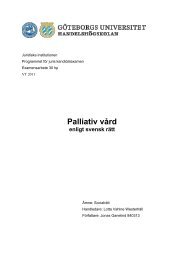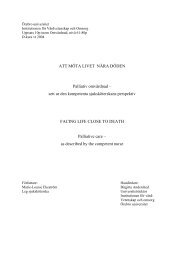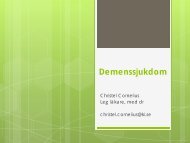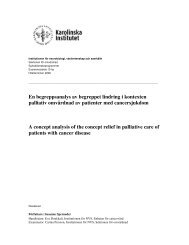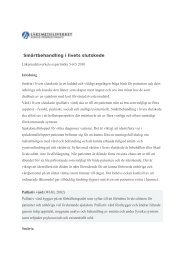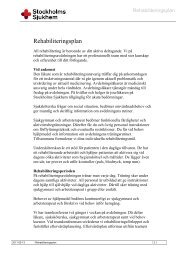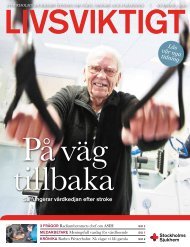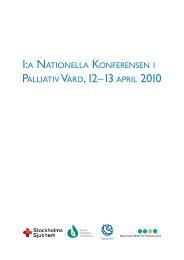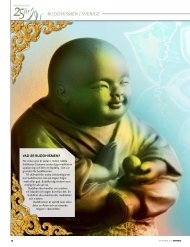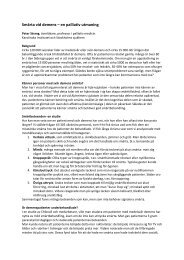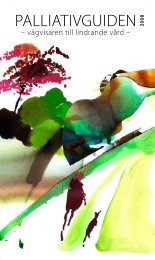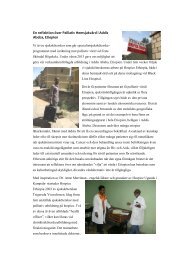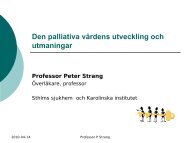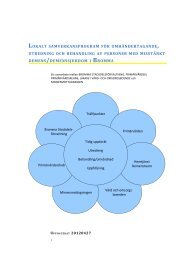Physiotherapy in palliative careâ - Stockholms sjukhem
Physiotherapy in palliative careâ - Stockholms sjukhem
Physiotherapy in palliative careâ - Stockholms sjukhem
Create successful ePaper yourself
Turn your PDF publications into a flip-book with our unique Google optimized e-Paper software.
ForewordPalliative care is good care at the end of life with the goal to give the best possible quality oflife to patients and their family. We who are work<strong>in</strong>g <strong>in</strong> <strong>palliative</strong> care th<strong>in</strong>k this is obvious.But what are the characteristics of good care at the end of life and what are the criteria? Howcan we know that what we do for patients and their families is most adequate and even mostcost effective?Most patients at the end of life are cared for with<strong>in</strong> primary health care, nurs<strong>in</strong>g homes and <strong>in</strong>hospitals. Many are also cared for with<strong>in</strong> specialized <strong>palliative</strong> care, <strong>in</strong> hospices and <strong>palliative</strong>care units as well as <strong>in</strong> specialized home care. Specialized <strong>palliative</strong> care is team-based andconsists of physicians and nurses but often also <strong>in</strong>clude assistant nurses, physiotherapists, socialworkers and occupational therapists and sometimes also a priest, a deacon and a dietician.The physiotherapist’s special competency <strong>in</strong> the <strong>palliative</strong> team emerges clearly <strong>in</strong> this cl<strong>in</strong>icalhandbook which firstly is aimed at physiotherapists car<strong>in</strong>g for severely ill and dy<strong>in</strong>g patients.But the handbook will also provide important <strong>in</strong>formation about physiotherapist work <strong>in</strong><strong>palliative</strong> care for other professions. As far as we know this is the first Swedish textbook onphysiotherapy <strong>in</strong> <strong>palliative</strong> care.Most of the symptoms and problems physiotherapists meet <strong>in</strong> cl<strong>in</strong>ical everyday life arerepresented <strong>in</strong> the handbook. Knowledge, both scientific as well as the experience-based, isdescribed and are the basis for suggested <strong>in</strong>terventions and treatments.We know thorough scientific studies for common physiotherapeutic treatments are lack<strong>in</strong>g,especially <strong>in</strong> <strong>palliative</strong> care. An <strong>in</strong>ventory of the most important pitfalls <strong>in</strong> knowledge should bethe basis for plann<strong>in</strong>g future research <strong>in</strong> physiotherapy <strong>in</strong> <strong>palliative</strong> care.We hope this handbook will be useful for the education of physiotherapists as well as areference book for physiotherapists meet<strong>in</strong>g and treat<strong>in</strong>g patients at the end of life.Stockholm September 2009Carl Johan FürstSenior consultantPalliative Centre<strong>Stockholms</strong> Sjukhem FoundationSylvia SauterRPT /Coord<strong>in</strong>atorPalliative Centre<strong>Stockholms</strong> Sjukhem Foundation<strong>Physiotherapy</strong> <strong>in</strong> <strong>palliative</strong> care – a cl<strong>in</strong>ical handbook Ulla Frymark, Lilian Hallgren, Ann‐Charlotte Reisberg 4
problems <strong>in</strong>crease and the possibility to aid the patient with better symptom relief and a betterquality of life improve.Palliative care can be divided <strong>in</strong>to an early and a late phase. In the early phase the cancer hasspread but is respond<strong>in</strong>g to the tumor specific treatment. The goal is then quality of life and toprolong life. Patients may sometimes live several years with the disease, for example withbreast- or prostate cancer. In the late phase the tumor specific treatment has stopped and thisphase is often just a few weeks or sometimes months. The goal for this phase is quality of lifeand not life prolongation.(3) Also dur<strong>in</strong>g this phase radiation therapy can be given to relievepa<strong>in</strong>.Palliative care has its roots <strong>in</strong> the modern hospice movement <strong>in</strong>itiated by Dame CicelySaunders. She was an English nurse, social worker and later physician who <strong>in</strong> her work foundthat the patients did not just have physical pa<strong>in</strong> but also psychological, social and existentialproblems. She founded St Christopher’s hospice <strong>in</strong> London 1967. Apart from be<strong>in</strong>g the firsthospice it was also the first educational and research unit <strong>in</strong> this subject. The goal was toimprove the condition of life of the dy<strong>in</strong>g person and the family. Cicely Saunders work <strong>in</strong>spiredothers to follow and today there are followers throughout the world <strong>in</strong>clud<strong>in</strong>g Sweden.The quality of life of the patientWhen cure is unlikely the patient can get help to ma<strong>in</strong>ta<strong>in</strong> and if possible improve the quality oflife. The physiotherapist has an important role to complement <strong>palliative</strong> care treatment with avariation of symptom relief activities and thus keep<strong>in</strong>g/improv<strong>in</strong>g the patients bodily functions.When a person is seriously ill the awareness of how important the physical body is for allexperiences and emotions becomes obvious. The state of the body decides what the patient cantake part <strong>in</strong> and do <strong>in</strong> everyday life.The state of the patient can vary considerably from day to day. Patients tell how stressful it is tosee the body change and how the illness has made them more vulnerable as to how their body istreated and cared for by others.(4) To be touched on the body <strong>in</strong> an emphatic way can givesatisfaction and confirmation.When the illness progresses the physiotherapeutic contribution can still be important and thecontact with the patient is of course easier if there has been an earlier relation with the patient.Examples can be passive movements, massage and show<strong>in</strong>g positions of rest. Advice andsupport to families and personnel can be given.<strong>Physiotherapy</strong> <strong>in</strong> <strong>palliative</strong> care – a cl<strong>in</strong>ical handbook Ulla Frymark, Lilian Hallgren, Ann‐Charlotte Reisberg 8
Palliative rehabilitationPatients live with their illness longer today <strong>in</strong> a <strong>palliative</strong> stage thanks to the improved medicaltreatment. Many of these patients get chronic functional impairment caused by the disease or bymedical or chirurgical treatments. This makes rehabilitation and physiotherapy very important.(5)Palliative rehabilitation is a comparatively new concept now more often used <strong>in</strong> <strong>palliative</strong> care,even if it is described already <strong>in</strong> the 1960s. The aim of hav<strong>in</strong>g a rehabilitative approach whentreat<strong>in</strong>g patients <strong>in</strong> <strong>palliative</strong> care is to set the goal for treatment so that the patient can keep orimprove functions and reduce the consequences of the disease for as long as possible. To losefunctions br<strong>in</strong>gs a changed view of one self and less possibility to <strong>in</strong>dependency which is verystressful for the patient as well as for the families. The goal for the physiotherapeutic treatmentis to keep as much <strong>in</strong>dependency as possible to make the important activities for the patienteasy. (6)To be able to plan the best physiotherapy treatment for the patient, to know about the patient’sprimary cancer diagnosis, the localization of the tumor and possible metastasis is important.The prognosis is of importance as well as ongo<strong>in</strong>g medical treatment and if there are otherdiagnoses. Any contradictions for physiotherapeutic treatments and if the patient is aware ofhis/hers illness, is also relevant <strong>in</strong>formation. (7)The physiotherapist role <strong>in</strong> <strong>palliative</strong> careThe overall aim for physiotherapy <strong>in</strong> <strong>palliative</strong> care is to help the patient reach the best possiblequality of life for the rest of the patient’s life, to look after the physical as well as thepsychological side for as long as possible. When the patient has an <strong>in</strong>curable disease the patient,families and health care personnel often accept a loss of function as <strong>in</strong>evitable and do not makeuse of functions still <strong>in</strong>tact. (8) The physiotherapist aim<strong>in</strong>g at rehabilitation and focus<strong>in</strong>g on thephysical capacity of the human body has an important role to play and to rem<strong>in</strong>d and activatethe functions still <strong>in</strong>tact.To see the physiotherapist is often positive and gives the patient a possibility to pause <strong>in</strong> theknowledge that death is near – a k<strong>in</strong>d of time and room to breathe. (4) With a cancer disease thebodily changes are obvious and many suffer from changes <strong>in</strong> their appearance, limitedmovements and impaired functions. Many medical activities like <strong>in</strong>jections, tak<strong>in</strong>g bloodsamples and <strong>in</strong>sert<strong>in</strong>g a catheter can be unpleasant and pa<strong>in</strong>ful. The touch and sk<strong>in</strong> contact thatthe physiotherapeutic treatment give to the patient is often one of the few positive bodilycontacts that the patient experiences.<strong>Physiotherapy</strong> <strong>in</strong> <strong>palliative</strong> care – a cl<strong>in</strong>ical handbook Ulla Frymark, Lilian Hallgren, Ann‐Charlotte Reisberg 9
When the patient is <strong>in</strong> a late <strong>palliative</strong> phase los<strong>in</strong>g bodily functions is to be expected. Thephysiotherapeutic activities <strong>in</strong> <strong>palliative</strong> care are often about keep<strong>in</strong>g the functions. Goalschange when worsen<strong>in</strong>g occurs. Usual qualitative assessments of physical functions can thenbecome a confirmation of deterioration and will not give the patients feel<strong>in</strong>g of support,security and expectations. (9)Patient Specific Functional Scale (PSFS) is an assessment <strong>in</strong>strument that grades the ability forthe patient to do important activities. It is important that the patient feels <strong>in</strong>volved <strong>in</strong> thephysiotherapeutic activities and that it is positive. For physiotherapy <strong>in</strong> <strong>palliative</strong> care it isimportant to show the patients the resources they still have left.Visual Analog Scale (VAS) Borg-RPE scale or Borg-CR10 scale can be used when you want tomeasure the patient’s feel<strong>in</strong>gs of the symptoms. The <strong>in</strong>tensity can be measured before and afteractivity treatment. For a patient <strong>in</strong> a late <strong>palliative</strong> stage of the disease with difficulty to judgetheir symptoms, the scale can be used verbally or ask questions that can be answered with a yesor no.Base of knowledgeAll care and treatment, <strong>in</strong>clud<strong>in</strong>g the physiotherapeutic, should be built on knowledge andcl<strong>in</strong>ical experience. Physiotherapists today strive to work <strong>in</strong> an evidence based way whichmeans <strong>in</strong>tegrat<strong>in</strong>g cl<strong>in</strong>ical knowledge, the patient’s unique situation and wishes with the bestpossible research evidence.Evidence based care means a systematic and conscious effort to provide care built on the bestavailable scientific evidence. Evidence here means the best available evidence, of effect orvalue of a treatment or other activity. The foundation for evidence based medic<strong>in</strong>e is thesystematic over view of exist<strong>in</strong>g research results. The Swedish Council on Health TechnologyAssessment – SBU has the mandate of the Swedish Government to comprehensively assesshealthcare technology from medical, economic, ethical, and social standpo<strong>in</strong>tsScientific assessment <strong>in</strong> health care aims to identify <strong>in</strong>terventions that offer the greatest benefitsfor patients while utiliz<strong>in</strong>g resources <strong>in</strong> the most efficient way. SBU is currently us<strong>in</strong>g fourlevels to grade evidence.<strong>Physiotherapy</strong> <strong>in</strong> <strong>palliative</strong> care – a cl<strong>in</strong>ical handbook Ulla Frymark, Lilian Hallgren, Ann‐Charlotte Reisberg 11
Strong scientific evidenceModerate scientific evidenceLimited scientific evidenceInsufficient or contradictory scientific evidence (10)For the search<strong>in</strong>g of articles the data bases MEDLINE, PEDro and Cochrane Library have beenused. In the first place bigger studies and review articles have been chosen, and where thesecould not be found smaller studies have been used.Psychological aspectsCrisisTo be hit by a life-threaten<strong>in</strong>g disease is a threat to the whole existence as well as to presentwell-be<strong>in</strong>g and future plans. It is aga<strong>in</strong>st common social roles with<strong>in</strong> the family and <strong>in</strong> work<strong>in</strong>glife. This causes a crisis with most people.The way the crisis is handled depends on several factors like how long the patient has knownabout the disease, how he was treated when diagnosed and at what age the patient wasdiagnosed. It is also important to consider what phase of life the patient is <strong>in</strong>, how differentsituations have been handled before <strong>in</strong> life and what k<strong>in</strong>d of social support there is.When a patient is affected by a severe illness it often leads to a crisis for the family.Patients <strong>in</strong> a late <strong>palliative</strong> stage have often been hit by recurrent threats and losses dur<strong>in</strong>g theirtime of disease, for example when treatments have had no effect. This causes the patient torepeatedly get <strong>in</strong>to a crisis situation. This often arouses strong feel<strong>in</strong>gs like rage, guilt, selfreproach,lonel<strong>in</strong>ess and sorrow.Worry / AnxietyThe feel<strong>in</strong>g of anxiety <strong>in</strong>dicates that someth<strong>in</strong>g unpleasant is about to happen. When the feel<strong>in</strong>gof worry gets stronger it is called anxiety. This is a natural reaction to threat and severe stressand can show as fear, worry, anger and panic. Often bodily symptoms like dyspnoea,palpitations, sweat<strong>in</strong>g, vertigo, nausea and muscle tensions can become apparent. Restlessnessand apathy can also be expressions of anxiety.<strong>Physiotherapy</strong> <strong>in</strong> <strong>palliative</strong> care – a cl<strong>in</strong>ical handbook Ulla Frymark, Lilian Hallgren, Ann‐Charlotte Reisberg 12
Assessment:How severe are the worries or the anxiety?The patient’s feel<strong>in</strong>gs of the severity of the symptoms can be estimated with a Visual analogScale – VAS before and after activities.Does the patient receive medication for his/her anxiety?Is it possible to divert the anxiety?What stage of disease is the patient <strong>in</strong>?Judg<strong>in</strong>g if a physiotherapeutic activity can be of help for the patient should be done afterconsult<strong>in</strong>g the rest of the staff.Treatment:By affect<strong>in</strong>g physical symptoms like muscle tensions, that divert the thoughts, physiotherapycan ease symptoms of milder forms of anxiety.Treatment alternatives can be relaxation exercises, massage and physical activities like walk<strong>in</strong>g.The choice of treatment depends on the stage of the disease the patient is <strong>in</strong>. In an early<strong>palliative</strong> phase physical exercises and relaxation activities can be useful. In later stages softmassage can be useful.The cl<strong>in</strong>ical experience of soft massage for anxiety patients is good. Patients <strong>in</strong> a late <strong>palliative</strong>stage receiv<strong>in</strong>g soft massage can feel satisfaction, get the feel<strong>in</strong>g of confirmation and free fromillness dur<strong>in</strong>g the massage as well as immediately after.There is a limited scientific documentation of how physical activity affects anxiety. Atemporary relief of situational anxiety can be noticed after physical activity.DepressionIt is common for the patient to feel low-spirited and sad because life is com<strong>in</strong>g to an end. Whenthe low spiritedness becomes more severe the word depression is used. Depression is caused bybiological, psychological and social factors. With a severe somatic illness several factors cantrigger and affect depression.<strong>Physiotherapy</strong> <strong>in</strong> <strong>palliative</strong> care – a cl<strong>in</strong>ical handbook Ulla Frymark, Lilian Hallgren, Ann‐Charlotte Reisberg 13
Depression can be hard to diagnose as it is natural to be low-spirited when one is severely illand many of the symptoms when depressed are common also when one is seriously ill. Theycan also be side effects of treatment.Common symptoms when depressed are low spiritedness, anxiety, sleep<strong>in</strong>g disorder, loss ofappetite, restlessness, tiredness and concentration problems. (7)Sometimes patients <strong>in</strong> an early <strong>palliative</strong> phase, who probably still have a long time to live butare sad because the disease makes them believe that death is imm<strong>in</strong>ent, become <strong>in</strong>active andbed bound.Except for medical treatment these patients need activat<strong>in</strong>g /mobiliz<strong>in</strong>g not to get secondarycomplications because they are <strong>in</strong>active and if possible to improve quality of life for the timethey have left.Assessment:The assessment if the patient is depressed should be done by a physician.What <strong>palliative</strong> stage of the disease is the patient <strong>in</strong>?How severe is the depression?Is the patient capable of co-operat<strong>in</strong>g <strong>in</strong> physiotherapeutic treatment?Does the patient want to?Treatment:For patients <strong>in</strong> an early or late <strong>palliative</strong> phase and who want and feel like tak<strong>in</strong>g walks, aquaticexercises or light fitness tra<strong>in</strong><strong>in</strong>g can be useful.The physical activity must be adapted to what the patient can handle, manage and want.Physical exercise can have a positive effect on depression. Physical exercise is best when it iscomb<strong>in</strong>ed with medical treatment and consultation. (12)<strong>Physiotherapy</strong> <strong>in</strong> <strong>palliative</strong> care – a cl<strong>in</strong>ical handbook Ulla Frymark, Lilian Hallgren, Ann‐Charlotte Reisberg 14
Common problems for patients who have cancer <strong>in</strong> a <strong>palliative</strong> phaseMetastasis of the skeletonMetastasis of the skeleton is the most common cause of pa<strong>in</strong> for patients with cancer.Metastases of the skeleton can be seen with all k<strong>in</strong>ds of cancer but most common with breastandprostate cancer. It is also common with metastasis of the skeleton with lung- kidney andthyroid gland cancer.The most common localization for metastases is the sp<strong>in</strong>e, skull bone, pelvis upper part thehumerus and upper part of the femur.Metastases of the skeleton often result <strong>in</strong> destruction of bone tissue – osteolysis – rather than thebone tissue becom<strong>in</strong>g osteosclerotic and the skeleton will gradually deteriorate and becomedecalcified. The skeleton around the metastasis becomes very fragile and the risk for fractures<strong>in</strong>creases. Radiation therapy is often used for pa<strong>in</strong> and also to prevent pathological fractures andcompression of the vertebrae or to lessen the compression of the sp<strong>in</strong>e. (13, 14)Pathological fracturesA pathological fracture is a fracture that can occur without prior trauma to the skeleton which isfragile for example because of metastasis. In the extremities it is mostly femur and humerus thatare affected. With a pathological fracture there is no normal fracture heal<strong>in</strong>g process. Surgicaltreatment can be needed to make the jo<strong>in</strong>t stable, pa<strong>in</strong> free and function<strong>in</strong>g. Radiation treatmentcan be used to reduce the pa<strong>in</strong> and <strong>in</strong>crease stability.The post operative mobiliz<strong>in</strong>g of the patient does not differ from mobiliz<strong>in</strong>g patients with otherfractures, but there might be a different pattern of pa<strong>in</strong> and the illness itself or the treatment canaffect the patient’s general condition and be a h<strong>in</strong>drance to mobilization. (14)It is common that patients who have had a pathological fracture <strong>in</strong> spite of the fact that theyhave received surgical treatment and can be mobilized, are very afraid of gett<strong>in</strong>g out of bed andstand<strong>in</strong>g on the leg. With <strong>in</strong>formation about the stability of the fracture, support andencouragement the patient can feel safe and dare to use the leg aga<strong>in</strong>, this way function can berega<strong>in</strong>ed and complications from ly<strong>in</strong>g <strong>in</strong> bed can be h<strong>in</strong>dered.<strong>Physiotherapy</strong> <strong>in</strong> <strong>palliative</strong> care – a cl<strong>in</strong>ical handbook Ulla Frymark, Lilian Hallgren, Ann‐Charlotte Reisberg 15
Compression of the vertebrae affect<strong>in</strong>g the sp<strong>in</strong>eMetastasis of the vertebrae can cause problems when there is pressure on a nerve root and withcompression of the sp<strong>in</strong>e. If there is a spontaneous fracture of the vertebrae the compression ofthe sp<strong>in</strong>e is often <strong>in</strong>creased and could result <strong>in</strong> paralysis. The surgical treatment aims atlessen<strong>in</strong>g pressure on the medulla through clean<strong>in</strong>g the vertebrae or through a lam<strong>in</strong>ectomyafter which the sp<strong>in</strong>e is stabilized with a spl<strong>in</strong>t. The most common symptom of compression ofthe sp<strong>in</strong>e is pa<strong>in</strong> <strong>in</strong> the back where the metastasis is located. Pa<strong>in</strong> can also radiate from thenerve root of the segment that is damaged. The pa<strong>in</strong> follows the segment of the dermatome.Other symptoms like ataxia, reduction of feel<strong>in</strong>g of sensitivity and of motor movements arepresent.It is important that the patient is mobilized early after surgical treatment to avoid complicationsfrom ly<strong>in</strong>g <strong>in</strong> bed. The exercises consist of tra<strong>in</strong><strong>in</strong>g stability of the torso, orthostatic tra<strong>in</strong><strong>in</strong>g andmov<strong>in</strong>g exercises and they should be customized accord<strong>in</strong>g to the level of the <strong>in</strong>jury and afterthe function of the patient follow<strong>in</strong>g surgery. (14) Much of the tra<strong>in</strong><strong>in</strong>g used for other patientswith sp<strong>in</strong>al <strong>in</strong>juries can be used also for these patients. The difference be<strong>in</strong>g, that aftermobiliz<strong>in</strong>g follow<strong>in</strong>g a pathological fracture, difference <strong>in</strong> pa<strong>in</strong> pattern and that the illness itselfand ongo<strong>in</strong>g treatment can affect the general condition of the patient and h<strong>in</strong>der mobilization.Pa<strong>in</strong>- reliev<strong>in</strong>g treatment like with TENS and acupuncture, can also be of help when the patienthas pa<strong>in</strong> from metastases of the skeleton. (14)Other severe symptoms that can be treated by a physiotherapistFatigueEverybody can relate to tiredness. Most of us have at some time felt totally exhausted andwithout energy and that can most often be cured with rest and a good night’s sleep. People withcancer can describe an unusual and extreme tiredness which does not disappear after rest<strong>in</strong>g orsleep<strong>in</strong>g. They feel as tired when they wake up as when they go to bed. The tiredness is felt likea chronic feel<strong>in</strong>g of unpleasantness, lack of energy, lack of concentration and forgetfulness. Inhealth care the term fatigue is used for this experience, a word that can be found <strong>in</strong> the Englishand French language but has no equivalent <strong>in</strong> the Swedish language. When speak<strong>in</strong>g with apatient the words tiredness or weakness is often used. (15)<strong>Physiotherapy</strong> <strong>in</strong> <strong>palliative</strong> care – a cl<strong>in</strong>ical handbook Ulla Frymark, Lilian Hallgren, Ann‐Charlotte Reisberg 16
Fatigue has been def<strong>in</strong>ed as “a subjective feel<strong>in</strong>g of tiredness, powerlessness and lack ofenergy.” (16) This symptom occurs frequently and 80% of all cancer patients experience thesymptom as troublesome. Dur<strong>in</strong>g chemotherapy treatment more than 99% of the patients statethat they are bothered by fatigue. Fatigue has a very negative impact on the quality of life ofthese patients.One of the latter def<strong>in</strong>itions (2007) of cancer related fatigue has been set up by the NationalComprehensive Cancer Network (NCCN). “Cancer-related fatigue is a distress<strong>in</strong>g, persistent,subjective sense of tiredness or exhaustion related to cancer or cancer treatment that is notproportional to recent activity and <strong>in</strong>terferes with usual function<strong>in</strong>g.” (17)The cause of fatigue is not known. Different factors like the disease itself, consequences of thedisease like anemia, <strong>in</strong>fections, cacexia, anxiety, stress and depression can play a role <strong>in</strong>develop<strong>in</strong>g the symptom fatigue. (15)Assessment:Talk<strong>in</strong>g to the patient can give you an idea of the severity of the fatigue the patient isexperienc<strong>in</strong>g, how it affects daily life, if it changes dur<strong>in</strong>g the day etc. A useful assessment toolis Borg-CR 10 scale.Treatment:Physical activity can lead to <strong>in</strong>creased energy for other activities.Advice - rest often - but for a short time each time. Advice the patient to plan activities so as touse the strength for what is important to him/her.Walk<strong>in</strong>g can be a useful activity and it is important to ensure that the patient is well nourishedand hydrated.Both research and cl<strong>in</strong>ical evidence show that physical activity has the best effect <strong>in</strong> decreas<strong>in</strong>gfatigue (18, 19, 20, 21, 22)Most of these studies on fatigue and physical exercise have been carried our when the patient isreceiv<strong>in</strong>g treatment or after treatment. Different types of physical exercises were <strong>in</strong>cluded e.g.gymnastics, fitness exercises and mobility tra<strong>in</strong><strong>in</strong>g. There are few studies with regard to patientswhere the disease is no longer curable, and also these studies show that symptoms of fatiguedecrease with physical activity. (23)<strong>Physiotherapy</strong> <strong>in</strong> <strong>palliative</strong> care – a cl<strong>in</strong>ical handbook Ulla Frymark, Lilian Hallgren, Ann‐Charlotte Reisberg 17
Physical weaknessDecreased muscle strength and perseverance is common with patients who have an advancedchronic illness. The causes can be <strong>in</strong>activity due to other symptoms like fatigue, pa<strong>in</strong> anddyspnoea and aversion to eat<strong>in</strong>g which generate a lack of energy.Patients <strong>in</strong> an advanced stage of cancer often show a visible loss of muscle mass because of<strong>in</strong>creased prote<strong>in</strong> destruction and a decrease of the prote<strong>in</strong> synthesis <strong>in</strong> the skeleton muscles.Some medication like corticosteroids also give a loss of muscle mass, which is noticeableespecially <strong>in</strong> the quadriceps muscles. (7)To lose physical capacity is very stressful for most patients. Tiredness and worry make itdifficult to take the <strong>in</strong>itiative to take on activities and to move on their own. Many patients donot feel confident with their own body. How much are you allowed to do, is it acceptable topush yourself etc? The patient is afraid of putt<strong>in</strong>g too much burden on family and close friendswhen there is an <strong>in</strong>creas<strong>in</strong>g need of help as the body is fail<strong>in</strong>g.An important role as a physiotherapist is to support the patient to carry out activity or exerciseson his/her own. To do functional exercises, to be able to be <strong>in</strong>dependent <strong>in</strong> daily life, like forexample be able to go to the toilet on ones own, is valuable for the patient. Inspire the patient byshow<strong>in</strong>g the resources the patient has. See the possibilities!An improved physical status can give the patient a feel<strong>in</strong>g of be<strong>in</strong>g <strong>in</strong> control and improves selfrespect. Increased self esteem can result <strong>in</strong> better social relations and reduced fear and anxiety.(24)Assessment:Is the disease caus<strong>in</strong>g bodily restrictions, if yes of what k<strong>in</strong>d?How does the patient handle the everyday activities, mov<strong>in</strong>g, walk<strong>in</strong>g upstairs, manag<strong>in</strong>gthresholds etc?How much can the patient manage and what does the patient want to achieve by exercis<strong>in</strong>g?Treatment:Physical activity can be def<strong>in</strong>ed as all bodily movement produced by skeleton muscles andresult<strong>in</strong>g <strong>in</strong> an energy use. When physical activity is planned, structured and recurrent it iscalled physical exercise and is aimed at improv<strong>in</strong>g or ma<strong>in</strong>ta<strong>in</strong><strong>in</strong>g a special physical function.(18)<strong>Physiotherapy</strong> <strong>in</strong> <strong>palliative</strong> care – a cl<strong>in</strong>ical handbook Ulla Frymark, Lilian Hallgren, Ann‐Charlotte Reisberg 18
Physical activity reduces the risk of thromboses, the levels of stress decreases and it works as aprophylaxes for decubitus, improves breath<strong>in</strong>g, keeps the stomach active etc. The exercises canbe done <strong>in</strong>dividually or <strong>in</strong> a group. They can be functional exercises with specific activities, ormore general movement exercises – or general health condition exercises.The goal with physical exercises for cancer patients <strong>in</strong> a <strong>palliative</strong> stage is to ga<strong>in</strong> positiveeffects on general health, strength of muscles, balance, psychological wellbe<strong>in</strong>g, anxiety/worry,depression and quality of life. Focus should be on keep<strong>in</strong>g movement and function.Dosage of tra<strong>in</strong><strong>in</strong>g is important and is diverse for different <strong>in</strong>dividuals. The background ofpeople vary, some have never exercised before where some have had physical tra<strong>in</strong><strong>in</strong>g as a lifestyle. A person who used to run several miles a week might not th<strong>in</strong>k that walk<strong>in</strong>g is exercise,even if the physical ability does not permit runn<strong>in</strong>g. It is therefore important to encourage thepatient to see “here and now” and not to compare with what the patient was able to beforecom<strong>in</strong>g ill.Access to a pool can be valuable. To exercise, movement, strength, balance and coord<strong>in</strong>ation <strong>in</strong>water is weight reliev<strong>in</strong>g and the patient can often perform movements he/she cannot do onland. Us<strong>in</strong>g float<strong>in</strong>g devices movements can be carried out also ly<strong>in</strong>g <strong>in</strong> the water.Many patients can use exercise mach<strong>in</strong>es. Choose some that are functionally well suited andstart on a low level both with weights and the amount of repetition. It is important that thepatient will not become exhausted. Strengthen<strong>in</strong>g exercises with barbells, weight cuffs or rubberbands are good alternatives if the patient is at home or no other equipment is available. Qi gongor yoga are other forms of exercises that prove useful and can also be executed sitt<strong>in</strong>g down.Access to passive cycl<strong>in</strong>g, tilt<strong>in</strong>g table and support for stand<strong>in</strong>g can ease mobiliz<strong>in</strong>g the patient.Even bed bound patients can ga<strong>in</strong> by physical exercise. To be helped to move aga<strong>in</strong>st manualresistance, actively reliev<strong>in</strong>g or totally passive often gives a good feel<strong>in</strong>g.There is strong evidence of positive effects of physical exercises for cancer patients for physicalfunction, muscle strengths, well be<strong>in</strong>g, anxiety, depression and <strong>in</strong> a wide sense quality of life.(22)<strong>Physiotherapy</strong> <strong>in</strong> <strong>palliative</strong> care – a cl<strong>in</strong>ical handbook Ulla Frymark, Lilian Hallgren, Ann‐Charlotte Reisberg 19
Pa<strong>in</strong>Pa<strong>in</strong> is a common symptom with patients <strong>in</strong> an advanced stage of cancer disease and it formsthe entire life situation for the patient. The pa<strong>in</strong> is often caused by the cancer disease and thelocation of the tumor and the metastasis.Radiation and chemo therapy treatment can cause both acute and a more cont<strong>in</strong>u<strong>in</strong>g pa<strong>in</strong> butcan also relieve pa<strong>in</strong> <strong>in</strong> a late <strong>palliative</strong> phase of the disease. With cancer diseases a generalweaken<strong>in</strong>g of the body occurs <strong>in</strong>clud<strong>in</strong>g a reduced immune system result<strong>in</strong>g <strong>in</strong> the patient be<strong>in</strong>gmore prone to thrombosis and herpes zoster which also can cause pa<strong>in</strong>.Many patients worry when they feel a new pa<strong>in</strong> they have never felt before and their thoughtsgo immediately to the cancer disease. It is good to know that the pa<strong>in</strong> is not necessarily alwaysrelated to the cancer disease but these patients can also get a sore muscle or a head ache likeanybody else. The pa<strong>in</strong> can also be secondary, such as from metastasis <strong>in</strong> the skeleton whichcan cause tension of the muscles. Many elderly patients can have other diagnosis that can causepa<strong>in</strong>, like e.g. arthrosis. (13)Pa<strong>in</strong> caused by cancer disease can be acute or durable. It can be a nociceptive pa<strong>in</strong> from themetastases of the skeleton, neurogenic pa<strong>in</strong> caused by pressure of the nerves or visceral pa<strong>in</strong>from tumor growth <strong>in</strong> <strong>in</strong>ner organs. Pa<strong>in</strong> caused by cancer disease can also be referred pa<strong>in</strong>. It iscommon that cancer patients can have more than one k<strong>in</strong>d of pa<strong>in</strong> and when the disease is <strong>in</strong> thef<strong>in</strong>al stages the percentage of patients with pa<strong>in</strong> <strong>in</strong>creases. (13, 25)As pa<strong>in</strong> is a symptom that <strong>in</strong>fluences the patient’s quality of life it is important to work with a<strong>palliative</strong> holistic po<strong>in</strong>t of view. This means that the pa<strong>in</strong> might not be just physical but can alsohave psychological, social and existential dimensions. In this situation other professionals likessocial workers, psychologists, priests etc can add their competence to reduce the patientssuffer<strong>in</strong>g by psychosocial and existential support (13).Most cancer patients <strong>in</strong> late stages of their disease receive pharmacological treatment for pa<strong>in</strong>.As a physiotherapist you can suggest other forms of treatment that, comb<strong>in</strong>ed with medication,can <strong>in</strong>crease pa<strong>in</strong> relief. (5) Medication for secondary muscle pa<strong>in</strong> does not work well andphysiotherapeutic treatment can have a good effect <strong>in</strong> these cases.(13)<strong>Physiotherapy</strong> <strong>in</strong> <strong>palliative</strong> care – a cl<strong>in</strong>ical handbook Ulla Frymark, Lilian Hallgren, Ann‐Charlotte Reisberg 20
Pa<strong>in</strong> analysisBefore choos<strong>in</strong>g what k<strong>in</strong>d of pa<strong>in</strong> treatment to use a common judgment and exam<strong>in</strong>ation needsto be performed where locality and range as well as character and <strong>in</strong>tensity of the pa<strong>in</strong> isanalyzed.What causes relief and what makes the pa<strong>in</strong> worse?Does the pa<strong>in</strong> <strong>in</strong>hibit movement?Has sensibility been affected?How is every day affected?What type of pa<strong>in</strong> is it: nociceptive, neurogenic or visceral?Is pa<strong>in</strong> correlated to movement or is it pa<strong>in</strong>ful when rest<strong>in</strong>g?Different methods of pa<strong>in</strong> treatmentPhysical activity /mobiliz<strong>in</strong>gAssessment:It is important to observe the general condition of the patient.What physical activities do not worsen the pa<strong>in</strong>?What motivation for activity has the patient?Are there metastases <strong>in</strong> the skeleton with risk of fractures?How does the patient manage to move?Treatment:Common exercises for patients with pa<strong>in</strong> who are <strong>in</strong> a <strong>palliative</strong> phase of the disease aresupported movement exercises, with a glid<strong>in</strong>g mat, with a manual support or if possible <strong>in</strong> apool. Exercises to practice movement are also common <strong>in</strong> order to f<strong>in</strong>d less pa<strong>in</strong>ful and ifpossible pa<strong>in</strong>-free ways to move. The goal is to make the patient unafraid to move and therebyavoid problems connected with immobility. An active treatment is often comb<strong>in</strong>ed with othermore passive alternatives <strong>in</strong> the pa<strong>in</strong> treatment.To <strong>in</strong>crease e.g. strength, endurance, coord<strong>in</strong>ation and stability exercise can have positiveeffects with patients who have a long history of pa<strong>in</strong>. There is strong evidence for physicalexercise with different problems with pa<strong>in</strong> like e.g. lumbago, where activities have to be<strong>in</strong>dividualized. The studies are not made specifically on cancer patients (26, 27).<strong>Physiotherapy</strong> <strong>in</strong> <strong>palliative</strong> care – a cl<strong>in</strong>ical handbook Ulla Frymark, Lilian Hallgren, Ann‐Charlotte Reisberg 21
Massage and relax<strong>in</strong>g techniquesMassage is def<strong>in</strong>ed as treatment of the body’s soft tissues carried out manually with the aim ofgett<strong>in</strong>g a vascular, muscular as well as a nervous system response. (28) Massage is one of theoldest known forms of heal<strong>in</strong>g that goes back 5000 years <strong>in</strong> Ch<strong>in</strong>a and has many positive bothphysical and psychological effects. Touch<strong>in</strong>g <strong>in</strong> connection with massage sets the body’s ownsubstances e.g. oxytoc<strong>in</strong> and seroton<strong>in</strong> free. They have a calm<strong>in</strong>g effect and reduce pa<strong>in</strong>.Relax<strong>in</strong>g techniques are often given under the guidance of a physiotherapist or <strong>in</strong> the form of ataped program. The program <strong>in</strong>forms the patient on how the relaxation can be carried out andthe patients can handle this program by themselves. Both massage and treatment with relaxationcan be given <strong>in</strong> order to reduce tensions of the muscles which have occurred due to pa<strong>in</strong>. (29)Assessment:In what stage of the disease is the patient?Has the patient pa<strong>in</strong> when palpated?Is the sk<strong>in</strong> frail?What can the patient psychologically accept?Treatment:Many patients <strong>in</strong> a late <strong>palliative</strong> phase of the disease have reduced muscle mass and frail sk<strong>in</strong>because the prote<strong>in</strong> destruction and corticosteroids. This makes a lighter massage more suitablefor these patients. In many <strong>palliative</strong> care units a light touch<strong>in</strong>g massage, tactile massage or softmassage is used rather than manipulat<strong>in</strong>g the soft tissues.Massage can be given dur<strong>in</strong>g all phases of the disease. Massage gives relief dur<strong>in</strong>g andimmediately after treatment. (11)Different relax<strong>in</strong>g techniques like progressive relaxation and autogenic exercise ly<strong>in</strong>g down orsitt<strong>in</strong>g as well as us<strong>in</strong>g a float<strong>in</strong>g device <strong>in</strong> the water can help people relax.Studies show that massage as pa<strong>in</strong> relief can work for a short while for cancer patients. (28, 30,31) There is not enough evidence to make conclusion about the effect of massage compared toother treatment alternatives. (26) There is also contradictory evidence that relaxation helps withendur<strong>in</strong>g pa<strong>in</strong>. There is also not sufficient knowledge about the effect with relaxation withneck- shoulder- pa<strong>in</strong>, rheumatic arthritis, myalgia or head ache. (26)<strong>Physiotherapy</strong> <strong>in</strong> <strong>palliative</strong> care – a cl<strong>in</strong>ical handbook Ulla Frymark, Lilian Hallgren, Ann‐Charlotte Reisberg 22
Heat and coldTreatment with heat <strong>in</strong>creases the circulation locally where the heat is applied and it has arelax<strong>in</strong>g effect on the muscles. Cold can be used as pa<strong>in</strong> relief <strong>in</strong> an acute <strong>in</strong>jury and reduce theswell<strong>in</strong>g that occurs and that can cause pa<strong>in</strong>. (28)Assessment:Check if the patient has <strong>in</strong>tact sensitivity and can judge if the temperature is appropriate.Treatment:Heat is often used to ease pa<strong>in</strong> like a hot pack, or a moist towel put <strong>in</strong> a plastic bag <strong>in</strong> the microwhich is easy to use and has a relax<strong>in</strong>g effect.Cold is not applied as often but can be used when an acute <strong>in</strong>jury occurs.Accord<strong>in</strong>g to cl<strong>in</strong>ical experience the feel<strong>in</strong>g of pa<strong>in</strong> is reduced when the hot pack is applied andstill warm.TENS‐ trans cutan electric nerv stimulationTENS activates the body’s own system to reduce pa<strong>in</strong>. With high frequency stimulus impulsessent to the nervous system the pa<strong>in</strong> reduc<strong>in</strong>g mechanisms blocks the pa<strong>in</strong> through a so calledgate-control. With low frequency stimulus endorf<strong>in</strong>es are set free which ease the pa<strong>in</strong>. TENScan be used with nociceptive and with neurogenic pa<strong>in</strong>. (26, 29)Assessment:It is important that the patient can expla<strong>in</strong> about the area of pa<strong>in</strong> to decide if the <strong>in</strong>tensity of theTENS- stimulation is correct. Check that the patient has sensibility. Contra <strong>in</strong>dications are thesame as with other patients that have pa<strong>in</strong>.Treatment:It might be necessary to test the <strong>in</strong>tensity several times before f<strong>in</strong>d<strong>in</strong>g the correct placement ofthe electrodes <strong>in</strong> order for TENS to give the best pa<strong>in</strong> relief. After <strong>in</strong>structions TENS can beused by the patient and that gives the patient the possibility to get better control of the pa<strong>in</strong>. Theelectrodes can sit dur<strong>in</strong>g the whole day and the patient can start the treatment by himself whenthe pa<strong>in</strong> starts.<strong>Physiotherapy</strong> <strong>in</strong> <strong>palliative</strong> care – a cl<strong>in</strong>ical handbook Ulla Frymark, Lilian Hallgren, Ann‐Charlotte Reisberg 23
There is not enough evidence to suggest that TENS treatment has effect on chronic pa<strong>in</strong> orcancer pa<strong>in</strong>. But there are studies show<strong>in</strong>g positive results of TENS-treatment result<strong>in</strong>g <strong>in</strong> pa<strong>in</strong>relief. (26, 32, 33)AcupunctureS<strong>in</strong>ce 1984 the Swedish National Board of Health and Welfare has allowed acupuncture astreatment for pa<strong>in</strong>. With traditional acupuncture special needles are applied <strong>in</strong>tra muscular <strong>in</strong>specific acupuncture-po<strong>in</strong>ts. Acupuncture br<strong>in</strong>gs a central <strong>in</strong>hibition of pa<strong>in</strong> through sett<strong>in</strong>g freeendorph<strong>in</strong>es, seroton<strong>in</strong> and noradrenal<strong>in</strong> and also a segmental <strong>in</strong>hibition through sett<strong>in</strong>g freeenkefal<strong>in</strong> which leads to less activity of the sympathetic nervous system and this reducesmuscle tonus. Acupuncture also stimulates the sett<strong>in</strong>g free of other neuropeptides that cause<strong>in</strong>creased circulation and has an anti <strong>in</strong>flammatory effect. (26, 29)Assessment:The patient should be cognitively clear and not be at the end of life. Contra <strong>in</strong>dications are thesame as for other patients with pa<strong>in</strong>.Treatment:Acupuncture can be used as pa<strong>in</strong> relief <strong>in</strong> comb<strong>in</strong>ation with other pa<strong>in</strong> reliev<strong>in</strong>g treatments.Usually acupuncture is given twice weekly but when a treatment series of several weeks is notfeasible a daily treatment can be tried, <strong>in</strong> order to get a quicker effect.There is strong evidence that acupuncture has a pa<strong>in</strong> reliev<strong>in</strong>g effect with several different pa<strong>in</strong>situations. (26)Acupuncture for cancer patients is useful to relieve symptoms. (34)Acupuncture can play a role <strong>in</strong> <strong>palliative</strong> care and reduce neuropathic and visceral pa<strong>in</strong>. (35)Acupuncture can be used to give a short pa<strong>in</strong> relief for patients with cancer pa<strong>in</strong> <strong>in</strong> a <strong>palliative</strong>stage of the disease. (31)Edema – Lymphatic edemaA common symptom that occur, for patients <strong>in</strong> a late <strong>palliative</strong> stage of the disease, is edemas <strong>in</strong>different parts of the body. They are caused by reduced activity, deep venous thrombosis orfailure of the heart, liver and kidneys. Lack of album<strong>in</strong> often <strong>in</strong> a late stage of the disease cancause general edema, but is more often concentrated <strong>in</strong> the legs.Many patients have several causes for the edema. It can be the result of a tumor or the patient’slack of album<strong>in</strong> lead<strong>in</strong>g to an edema. It can cause a general edema from the lower parts of the<strong>Physiotherapy</strong> <strong>in</strong> <strong>palliative</strong> care – a cl<strong>in</strong>ical handbook Ulla Frymark, Lilian Hallgren, Ann‐Charlotte Reisberg 24
extremities up over the torso to the arm pits. Patients can have the feel<strong>in</strong>g that the edema causesheav<strong>in</strong>ess and a tension as well as a feel<strong>in</strong>g of weight<strong>in</strong>ess. Many become disabled as a result ofthe edemas.Lymphatic edemas are caused by the lack of transport capacity <strong>in</strong> the lymphatic system. It canoccur after <strong>in</strong> a grow<strong>in</strong>g tumor, after surgery or radiation, after <strong>in</strong>fection or be congenital.Lymphatic edemas most frequently occur <strong>in</strong> arms and legs but can also occur <strong>in</strong> the torso, headand neck area and <strong>in</strong> genitals which very often is experienced as very <strong>in</strong>tricate.For patients <strong>in</strong> a late <strong>palliative</strong> stage of disease medication with corticosteroids is quitecommon. Corticosteroids make the sk<strong>in</strong> become very frail which <strong>in</strong>creases the risk of sk<strong>in</strong><strong>in</strong>fections like erysipelas that can be treated with antibiotics. Wounds or lymphatic fistulas<strong>in</strong>crease the risk for leakage of liquid through the sk<strong>in</strong>, so called lymphatic leakage. (7, 36, 37,38) Good sk<strong>in</strong> care like us<strong>in</strong>g a soften<strong>in</strong>g sk<strong>in</strong> lotion can prevent wounds and reduce the risk ofsk<strong>in</strong> <strong>in</strong>fections.Assessment:Differential diagnosis is made together with a physician to diagnose or exclude thrombosisand/or suspected erysipelas.How did the swell<strong>in</strong>g start and where is it situated and does it change dur<strong>in</strong>g the day?How does the sk<strong>in</strong> look?If some other parts of the body rather than feet and legs are swollen and if you feel uncerta<strong>in</strong> asto how the patient is best treated - consult a lymphatic therapist.Treatment:The most common treatment for at patient <strong>in</strong> a late stage of <strong>palliative</strong> disease with swollen legsis to try out compression stock<strong>in</strong>gs <strong>in</strong> compression class1, so called anti thrombosis stock<strong>in</strong>gs.If the sk<strong>in</strong> is fragile the extremity should be bandaged. The expected effect of the treatment is toreduce the volume of the edema, improve the status of the sk<strong>in</strong> and to stop the leakage of thelymphatic liquid and improve function. (7, 36) Make sure that the edema does not move fromthe leg to the abdomen or to the genitals. When the patient is <strong>in</strong> a late <strong>palliative</strong> stage of thedisease, make an assessment of the effect of improved function and reduced unpleasantness aswell as that the treatment does not h<strong>in</strong>der the patients daily activities.Comb<strong>in</strong>ed Decongestive Therapy – CDT is an established treatment method used <strong>in</strong> Swedenand <strong>in</strong>ternationally and is carried out by lymphatic therapists. The therapy consists of<strong>Physiotherapy</strong> <strong>in</strong> <strong>palliative</strong> care – a cl<strong>in</strong>ical handbook Ulla Frymark, Lilian Hallgren, Ann‐Charlotte Reisberg 25
compression, manual lymphatic dra<strong>in</strong>age, advice and regime, sk<strong>in</strong> care and exercises. The mostimportant component is compression, either through stock<strong>in</strong>gs or bandag<strong>in</strong>g. The patient shouldtake active part <strong>in</strong> the treatment as much as possible.Manual lymphatic dra<strong>in</strong>age can give relief, reduced edema and also relaxation.The cl<strong>in</strong>ical experience of compression is very good. Evidence for the effect of manuallymphatic dra<strong>in</strong>age as a treatment added to compression for patients with an arm edema afterbreast cancer is limited. (39, 40) There are few studies made with patients hav<strong>in</strong>g an edema or alymphatic edema <strong>in</strong> late <strong>palliative</strong> stages of the disease.DyspnoeaDyspnoea is a common symptom for patients <strong>in</strong> the late stages of a cancer disease. 70% ofpatients with lung cancer report hav<strong>in</strong>g dyspnoea. Common causes for dyspnoea are pleuraliquid, ascites or enlarged liver. Many patients with lung cancer also have other diseases likeCOPD and fibrosis of the lung caused by radiation which also can cause dyspnoea.The feel<strong>in</strong>g of gasp<strong>in</strong>g for air and the experience that it is tir<strong>in</strong>g to breathe are used as criteriafor dyspnoea. It is often associated with physical efforts or psychic stra<strong>in</strong> and creates anxiety.Severe dyspnoea when speak<strong>in</strong>g is frustrat<strong>in</strong>g and can make socializ<strong>in</strong>g with other peoplealmost impossible. The experience of dyspnoea is subjective and can not be measuredobjectively, but the <strong>in</strong>tensity can be estimated with VAS or Borg-RPE scale. (7)Assessment:Read the anamnesis from the patient’s records.Look at the breath<strong>in</strong>g pattern; does the patient use accessory breath<strong>in</strong>g muscles?Does the dyspnoea stop the patient from carry<strong>in</strong>g out functional activities?Can the patient cough when he/she has problems with phlegm?<strong>Physiotherapy</strong> <strong>in</strong> <strong>palliative</strong> care – a cl<strong>in</strong>ical handbook Ulla Frymark, Lilian Hallgren, Ann‐Charlotte Reisberg 26
Treatment:Give <strong>in</strong>structions for useful sitt<strong>in</strong>g positions and movements so that they are made with as littleeffort as possible. Aids such as a walker, other gait aids or wheel chair are facilitat<strong>in</strong>g. Give<strong>in</strong>structions <strong>in</strong> resistance, blow through closed lip breath<strong>in</strong>g. Another option is that the patientcan blow <strong>in</strong> a hose - 1cm <strong>in</strong> diameter - <strong>in</strong> a bottle filled with water that makes light resistance.A so called BA-tube and breath<strong>in</strong>g tra<strong>in</strong>er can also be of help.Breath<strong>in</strong>g exercises are very important, ord<strong>in</strong>ary deep breath<strong>in</strong>g where the patient is encouragedto, if possible, <strong>in</strong>hale through the nose and exhale through the mouth. Breath<strong>in</strong>g is exercisedthrough mak<strong>in</strong>g the patient observant of the synchronized movements of the abdomen whenbreath<strong>in</strong>g by e.g. putt<strong>in</strong>g a hand on the stomach. This can be comb<strong>in</strong>ed with closed lipbreath<strong>in</strong>g. If the patient has phlegm use cough<strong>in</strong>g support. Give <strong>in</strong>structions about the huff<strong>in</strong>gtechnique if the patient has difficulty cough<strong>in</strong>g.The physiotherapist can <strong>in</strong>struct the <strong>in</strong>halation technique when us<strong>in</strong>g nebuliz<strong>in</strong>g equipmentwhen the patient needs to <strong>in</strong>hale medication or natrium clorid solution. To stress therelationship between muscle tension and breath<strong>in</strong>g, exercises for the shoulder and chest arecarried out. Massage of the shoulders and neck can reduce anxiety.For patients <strong>in</strong> a later <strong>palliative</strong> phase of the disease, where breath<strong>in</strong>g exercises can be tootir<strong>in</strong>g, <strong>in</strong>structions on rest<strong>in</strong>g positions can be more relevant. Different rest<strong>in</strong>g positions give arelaxation of the muscles that can facilitate breath<strong>in</strong>g and lessen dyspnoea and anxiety. It isimportant to give <strong>in</strong>formation also to the family to create calmness, comfort and well-be<strong>in</strong>g forthe patient.Most of the studies have been carried out on COPD-patients, some studies were carried out onpatients with an advanced cancer disease. There is reasonably strong evidence for breath<strong>in</strong>gexercises and us<strong>in</strong>g walk<strong>in</strong>g aids to m<strong>in</strong>imize the efforts (41).NauseaWith an advanced cancer disease 40 – 70 % of the patients are troubled by nausea and vomit<strong>in</strong>g.(5) These symptoms can be triggered by different causes. The cancer disease can causeileus/subileus and so can metastases <strong>in</strong> the liver and bra<strong>in</strong> which can cause nausea andvomit<strong>in</strong>g. Treatment with chemotherapy, radiation and other medication and former abdom<strong>in</strong>alsurgery can cause nausea and vomit<strong>in</strong>g. Nausea can be triggered by mov<strong>in</strong>g as well as bysymptoms like anxiety, constipation and pa<strong>in</strong>. (25)<strong>Physiotherapy</strong> <strong>in</strong> <strong>palliative</strong> care – a cl<strong>in</strong>ical handbook Ulla Frymark, Lilian Hallgren, Ann‐Charlotte Reisberg 27
3.A 64-year old woman liv<strong>in</strong>g alone with a newly diagnosed lung cancer that has spread to theskeleton. She lives <strong>in</strong> an older apartment with a small elevator. She had a spontaneous fractureof the right femur and has been operated on and received a hip replacement. Free mobilizationis permitted, but she should not be sitt<strong>in</strong>g with less than 90 degrees <strong>in</strong> her hips and not cross herlegs. She has anxiety and is very afraid when mobilized to a stand<strong>in</strong>g position. She does nottrust her leg and has pa<strong>in</strong> <strong>in</strong> the operated area when mov<strong>in</strong>g.Give an example of the goal for the physiotherapeutic treatment. In what phase of the crisis isthe patient? What other professions could be useful to consult <strong>in</strong> her rehabilitation? How canthe physiotherapist support the patient? Suggest <strong>in</strong>itial movement exercises. Which aids doesthe patient need?4.A 70 – year old man liv<strong>in</strong>g alone. He was diagnosed with ALS a few years ago and has nowconstant assistants. He has a ventilator 24 hours and a cough-assist to get rid of the phlegm. Hehas progressively had more difficulties <strong>in</strong> mov<strong>in</strong>g. Previously he was able to sit <strong>in</strong> a wheel chairthat he could handle on his own. Now he has an electric wheel chair that he still can manage <strong>in</strong>his house if he gets help to put his hand on the joy stick. He is now troubled by weakness of themuscles and pa<strong>in</strong> <strong>in</strong> the neck-shoulder area and that makes it harder for him to hold his head.His lower legs have begun to swell.Suggest the physiotherapeutic goal for the patient. Is there a form of exercises that the patientcan handle actively? Is there a need for passive treatment? Does the patient need orthopedicaids? Suggest how his leg edemas should be treated.5.A 25-year old woman liv<strong>in</strong>g with her boyfriend. She is <strong>in</strong> close contact with her parents and 2sibl<strong>in</strong>gs. She has breast cancer <strong>in</strong> her left breast that has spread to the lymphatic nodes twoyears ago. Initially she was treated with chemotherapy and afterwards had an operation and wasthen treated with radiation. For the past two months she has metastases <strong>in</strong> the liver and the lung.She has a lymph edema <strong>in</strong> her left arm and has had a compression stock<strong>in</strong>g which is not<strong>Physiotherapy</strong> <strong>in</strong> <strong>palliative</strong> care – a cl<strong>in</strong>ical handbook Ulla Frymark, Lilian Hallgren, Ann‐Charlotte Reisberg 31
function<strong>in</strong>g. She also has pa<strong>in</strong> <strong>in</strong> her neck and <strong>in</strong> the left shoulder. She is used to exercis<strong>in</strong>g andfeels that she has a hard time exercis<strong>in</strong>g as usual as her body does not obey her and shebecomes breathless very quickly. She has a wish to exercise but needs to get her exerciseprogram adapted to her new physical condition.Suggest the physiotherapeutic goal for the patient. What k<strong>in</strong>d of exercises could be useful? Howcan she be helped with her lymph edema? What could be the reason for her pa<strong>in</strong>? Is there aneed for more <strong>in</strong>vestigation of her pa<strong>in</strong>? What k<strong>in</strong>d of treatment for her pa<strong>in</strong> would be useful totry?F<strong>in</strong>allyPhysiotherapeutic <strong>palliative</strong> care is by necessity focused on the body. For a person <strong>in</strong> the mostproblematic time of life, just before leav<strong>in</strong>g life, it is pa<strong>in</strong>fully clear how important the body is.Movement is a symbol of life and maybe it is the most important time to move when one is nolonger able to, to feel that one is still alive and get confirmation that one still belongs to life.Today it is essential to have a rehabilitative approach as people live longer, but often withfunctions reduced due to treatment. Physiotherapists have - with their specific competence - atask to prevent, exam<strong>in</strong>e and treat functional barriers that limit or threaten to limit the humanmovement. By facilitat<strong>in</strong>g the patient to keep or improve functions or through technical aids the<strong>in</strong>dependence and the quality of life of the patient can improve, <strong>in</strong> all stages of life.Please note that the physiotherapist’s symptom relief and activat<strong>in</strong>g treatments have very fewside effects!The exercises and physical activities that the physiotherapist offers resemble life when thepatient was still healthy. This gives the patients some breath<strong>in</strong>g-space, paus<strong>in</strong>g from thoughts ofillness and death - an important rest for the patient and a possibility to recuperate.Physiotherapists must always strive to base treatments on best available knowledge. Theexist<strong>in</strong>g evidence for different physiotherapeutic treatment methods are <strong>in</strong> some areas notsufficient and <strong>in</strong> <strong>palliative</strong> care few studies have been carried out. This does not mean that thetreatment is useless but that there is a need for more research <strong>in</strong> this area.<strong>Physiotherapy</strong> <strong>in</strong> <strong>palliative</strong> care – a cl<strong>in</strong>ical handbook Ulla Frymark, Lilian Hallgren, Ann‐Charlotte Reisberg 32
Through <strong>in</strong>creased knowledge about physiotherapy treatment methods for patients <strong>in</strong> the laststages of life we hope that this group of patients will receive a better quality of life.Last but not least we would like to thank our colleagues for valuable <strong>in</strong>put dur<strong>in</strong>g the time ofwrit<strong>in</strong>g this handbook. Ylva Dahl<strong>in</strong>, Ingrid Gulde, Pia Gunnarsson, Elisabeth Wahlberg, HelgaHirschfeld and Car<strong>in</strong>a Persson.References(1) Vård i livets slutskede - Socialstyrelsens bedömn<strong>in</strong>g av utveckl<strong>in</strong>gen i landst<strong>in</strong>g ochkommuner, Socialstyrelsen artikelnr: 2006-103-8. sid 8(2) National cancer control programs: policies and managerial guidel<strong>in</strong>es, 2nd ed Geneva.World Health Organisation 2002. Svensk översättn<strong>in</strong>g: Kenne-Sarenmalm E, Fürst CJ, StrangP, Ternestedt BM.(3) Strang P. Utveckl<strong>in</strong>g <strong>in</strong>om den svenska palliativa vården. Nordisk geriatrik nr 6, 2008.(4) Sand L. Existentiell challengers and cop<strong>in</strong>g <strong>in</strong> <strong>palliative</strong> cancer care. Experiences ofpatients and family members. Karol<strong>in</strong>ska Institutet 2008.(5) Doyle D, Hanks G, Cherny N, Calman K. Oxford textbook of <strong>palliative</strong> medic<strong>in</strong>e. Thirdedition 2004.(6) Bruera E, Higg<strong>in</strong>son I, Ripamonti C, von Gunten C. Textbook of <strong>palliative</strong> medic<strong>in</strong>e,Oxford university press <strong>in</strong>c USA 2006.(7) Kaasa S (red). Palliativ behandl<strong>in</strong>g och vård. Studentlitteratur 2001.<strong>Physiotherapy</strong> <strong>in</strong> <strong>palliative</strong> care – a cl<strong>in</strong>ical handbook Ulla Frymark, Lilian Hallgren, Ann‐Charlotte Reisberg 33
(8) Palliativ vård relaterat till tumörsjukdom – en personalhandbok Skåne sept 07.www.stockholms<strong>sjukhem</strong>.se/spn(9 ) Dahl<strong>in</strong> Y, Heiwe S. Patients´Experiences of Physical Therapy with<strong>in</strong> Palliative CancerCare. Journal of Palliative Care 25:1/2009;12-20.(10) www.sbu.se(11) Seiger Cronfalk B. Be<strong>in</strong>g <strong>in</strong> safe hands. The experiences of soft tissue massage as acomplement <strong>in</strong> <strong>palliative</strong> care. Intervention studies concern<strong>in</strong>g patients, familys and nurs<strong>in</strong>gstaff. Karol<strong>in</strong>ska Institutet 2008.(12) FYSS- fysisk aktivitet i sjukdomsprevention och sjukdomsbehandl<strong>in</strong>g. StatensFolkhälso<strong>in</strong>stitut, rapport nr 2008:4.(13) Strang P. Cancerrelaterad smärta onkologiska och palliativa aspekter. Studentlitteratur2003.(14) Vårdprogram 2001. Skelettmetastaser. Onkologiskt Centrum Stockholm-Gotland.(15) Lund Hagel<strong>in</strong> C. Fatigue <strong>in</strong> patients with advanced cancer, aspects of assessment andmeasurements. Karol<strong>in</strong>ska Institutet 2008.(16) Radbruch L, Strasser F et al. Fatigue <strong>in</strong> <strong>palliative</strong> care patients – an EAPC approach.Palliativ Med 2008;22:13-32.(17) Mock V, Abernethy A, Atk<strong>in</strong>son A, Barsevick A, Berger AM, Cella D et al. NCCNCl<strong>in</strong>ical Practice Guidel<strong>in</strong>es <strong>in</strong> Oncology TM Cancer-related fatigue. 2007 (cited 2008-3-31):Available from http://www.ncc.org/professional/physician_gls/PDF/fatigue.pdf(18) Dimeo FC. Effects of exercise on cancer-related fatigue. Cancer 2001:92:1689-1693.(19) Dimeo FC, Stieglitz RD, Novelli-Fischer U, Fetscher S, Keul . Effects of physical activityon the fatigue and psychologic status of cancer patients dur<strong>in</strong>g chemotherapy. Cancer1999:85:2273-2277.<strong>Physiotherapy</strong> <strong>in</strong> <strong>palliative</strong> care – a cl<strong>in</strong>ical handbook Ulla Frymark, Lilian Hallgren, Ann‐Charlotte Reisberg 34
(20) Cramp F, Daniel J. Exercise for the management of cancer-related fatigue <strong>in</strong> adults.Review. The Cochrane Library 2008, issue 3.(21) Courneya KS, Mackey JR, Jones LW. Coop<strong>in</strong>g with cancer can exercise help? PhysicianSportsmed 2000;28:49-73.(22) Pedersen BK, Salt<strong>in</strong> B. Evidence for prescrib<strong>in</strong>g exercise as therapy <strong>in</strong> chronic disease.Scand J Med Sci Sports 2006;16(suppl.1):3-63.(23) Oldervoll LM, Loge JH, Paltiel H, Asp MB, Vidvei U, Wiken AN et al. The Effect of aPhysical Exercise Program <strong>in</strong> Palliative Care: A Phase II Study. Journal of Pa<strong>in</strong> and SymtomManagement 2006;31(5)421-30.(24) Santesson U (red). Effekter av fysisk trän<strong>in</strong>g vid olika sjukdomstillstånd. SISUidrottsböcker 2007.(25) Strang P. Symtoml<strong>in</strong>dr<strong>in</strong>g vid cancer – en vägledn<strong>in</strong>g. Pharamacia o Upjohn Sverige ab1999.(26) SBU- Statens beredn<strong>in</strong>g för medic<strong>in</strong>sk utvärder<strong>in</strong>g. Metoder för behandl<strong>in</strong>g av långvarigsmärta. En systematisk litteraturöversikt april 2006.(27) Mann<strong>in</strong>on AF, Taimela S, Müntener M, Dvorak J. Active therapy for chronic low backpa<strong>in</strong> part 1. Effects on back muscle activation fatigability and strength. Sp<strong>in</strong>e 2001; 26:897-908.(28) Wilk<strong>in</strong>son S et al. Massage for symptom relief <strong>in</strong> patients with cancer: systematic review2008; 63(5)430-439.(29) Strang P, Werner M. Smärta och smärtbehandl<strong>in</strong>g, Liber 2003.(30) Fellowes D et al. Aromatherapy and massage for symptom relief <strong>in</strong> patients with cancer.Cochrane Database of Systematic Reviews 2004, Issue 3.(31) Pan C M, Morrison S, Ness J, Fugh-Berman A, Leipzig R M. Complementary andalternative medic<strong>in</strong>e <strong>in</strong> the management of pa<strong>in</strong>, dyspnoea, and nausea and vomit<strong>in</strong>g near end oflife: a systematic review. Journal of Pa<strong>in</strong> and Symptom Management 2000;5:374-387.<strong>Physiotherapy</strong> <strong>in</strong> <strong>palliative</strong> care – a cl<strong>in</strong>ical handbook Ulla Frymark, Lilian Hallgren, Ann‐Charlotte Reisberg 35
(32) Robb KA, Bennett MI, Johnson MI, Simpson KJ, Oxberry SG. Transcutaneous electricnerve stimulation (TENS) for cancer pa<strong>in</strong> <strong>in</strong> adults. Cochrane Database of Systematic Reveiws2008, Issue 3.(33) Nnoaham KE,Kumbang J. Transcutaneous electrical nerve stimulation (TENS) for chronicpa<strong>in</strong>. Cochrane Database of Systematic Reviews 2008, Issue 3.(34) Sagar S M. Acupuncture as an evidence based option for symptom control <strong>in</strong> cancerpatients. Complementary and alternative therapies <strong>in</strong> oncology. Current treatment options <strong>in</strong>oncology 2008.(35) Standish L J, Kozak L, Congdon S. Acupuncture is underutilized <strong>in</strong> hospice and <strong>palliative</strong>care. American Journal of Hospice & Palliative Medic<strong>in</strong>e 2008.(36) Henriksson T-G, Wallenius I, Lymfödem. Uppkomst, kl<strong>in</strong>ik och behandl<strong>in</strong>g.Studentlitteratur 1994.(37) Riksplaner<strong>in</strong>gsgruppen mot lymfödem. Lymfödem, Nationellt vårdprogram 2003. Initieratav Cancerfonden.(38) Frid M, Strang P, Friedrichsen M, Johansson K . Lower Limb Lymphedema: Experiencesand Perceptions of Cancer Patients <strong>in</strong> the Late Palliative Stage. Journal of Palliative Care22:1/2006; 5-11.(39) SBU Alert-rapport nr 2005-04. Manuellt lymfdränage som tilläggsbehandl<strong>in</strong>g vidarmlymfödem efter bröstcancer.(40) Badger CM, Peacock JL, Mortimer PS. A randomized, controlled, parallel-group cl<strong>in</strong>icaltrial compar<strong>in</strong>g multilayer bandag<strong>in</strong>g followed by hosiery versus hosiery alone <strong>in</strong> the treatmentof patients with lymphedema of the limb. Cancer 2000; 88(12):2832-2837.(41) Bausewe<strong>in</strong> C, Gysels M, Higg<strong>in</strong>son IJ. Non pharmacological <strong>in</strong>terventions forbreathlessness <strong>in</strong> advanced stages of malignant and non-malignant diseases. Review TheCochrane Library 2008; Issue 2.<strong>Physiotherapy</strong> <strong>in</strong> <strong>palliative</strong> care – a cl<strong>in</strong>ical handbook Ulla Frymark, Lilian Hallgren, Ann‐Charlotte Reisberg 36
(42) Billhult A, Bergbom I, Stener-Victor<strong>in</strong> E. Massage relives nausea <strong>in</strong> women with breastcancer who are undergo<strong>in</strong>g chemotherapy.The journal of alternative and complementerymedic<strong>in</strong>e,2007;13 1:53-57.(43) Lee A, Done ML. Stimulation of the wrist acupuncture po<strong>in</strong>t P6 for prevent<strong>in</strong>gpostoperative nausea and vomit<strong>in</strong>g. Cochrane Database of Systematic Reviews 2004 Issue 3.(44) Nystrom E, Ridderstrom G, Leffler A-S. Manual acupuncture as an adjunctive treatmentof nausea <strong>in</strong> patients with cancer <strong>in</strong> <strong>palliative</strong> care- a prospective, observational pilot study.Acupuncture <strong>in</strong> medic<strong>in</strong>e 2008;26(1):27-32.(45) Friedrichsen M, Erichsén E. The lived experience of constipation <strong>in</strong> cancer patients <strong>in</strong><strong>palliative</strong> hospital-based home care. International Journal of Palliative Nurs<strong>in</strong>g 2004; 10.(46) Hellström P. Mag-tarmkanalens sjukdomar. Fyss – Fysisk aktivitet i sjukdomspreventionoch sjukdomsbehandl<strong>in</strong>g 2003; 265- 275.(47) Preece J. Introduc<strong>in</strong>g abdom<strong>in</strong>al massage <strong>in</strong> <strong>palliative</strong> care for the relief of constipation.Complementary Therapies <strong>in</strong> Nurs<strong>in</strong>g and Midwifery 2002; Volume 8, Issue 2; 101-105.(48) Ernst E. Abdom<strong>in</strong>al Massage Therapy for Chronic Constipation: A Systematic Review ofControlled Cl<strong>in</strong>ical Trials. Forschende Komplementärmediz<strong>in</strong>/Research <strong>in</strong> ComplementaryMedic<strong>in</strong>e 1999;Vol 6, No 3; 149-151.<strong>Physiotherapy</strong> <strong>in</strong> <strong>palliative</strong> care – a cl<strong>in</strong>ical handbook Ulla Frymark, Lilian Hallgren, Ann‐Charlotte Reisberg 37



